American Towman Magazine – August 2025
As Told by Rogers Towing & Transport and Gerlock Towing & Heavy Haul
A perfect storm of circumstances created a worst-case scenario for recovery efforts on the steep, rocky terrain of the Cascade Mountains, blanketed by a recent snowfall. At 7:00 a.m. on December 14, 2024, a semi-truck hauling a load of snail poison, a common pesticide, rolled off the sharp curve of a remote logging road, risking contamination of drinking water for the nearby communities of Sweet Home, and Lebanon, Oregon. The trailer load of pesticides also threatened endangered fish species in a nearby creek. Fortunately, the driver of the semi survived the crash, but had to walk several miles to seek help.
Recovery efforts would require the audacious endeavors of two tow companies, Rogers Towing & Transport and Gerlock Towing & Heavy Haul, working in close concert. It was described as one of the most difficult operations that the responders had ever experienced (Another tow company called upon by Rogers to help didn’t want any part of the job, calling it “a death trap!”).
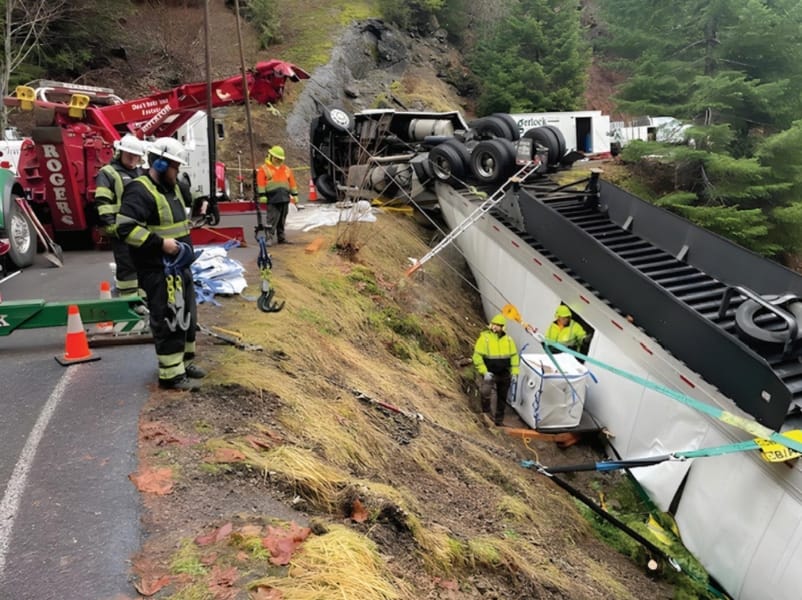
Upon arriving on scene Saturday, Tanner Rucker, Operations & Logistics Manager for Rogers Towing, discovered a much more serious situation than what was described. The truck was unstable and sliding towards the creek, located only ten feet away. Then and there, the towmen on site decided to go back on Sunday and formulate a comprehensive game plan. On Monday, after a meeting with U.S. Forest Service, Rogers Towing decided to use its Century 1140 rotator to anchor the truck and trailer to prevent it from going any further down the canyon.
In addition, the IMT (Incident Management Team) included more than a dozen different government, environmental, hazmat, and mountain rescue agencies. Emergency responders were restricted by the IMT to daytime operations only. This decision was made due to the remoteness of the crash site, bad weather, poor communications, the complexity of the recovery, and the load of hazardous materials. In the event of a possible spill, the Northwest Fire Fighters environmental team installed four temporary net catch systems and booms in the frigid, fast-moving creek below.
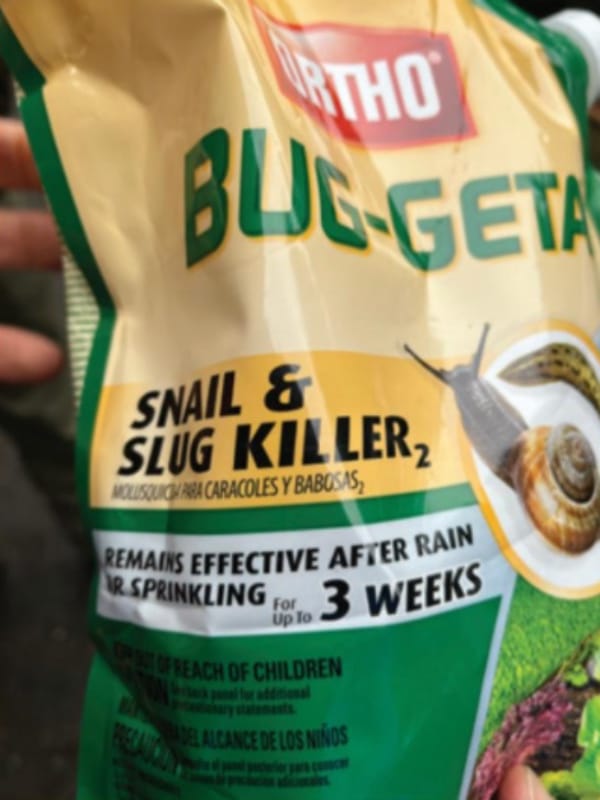
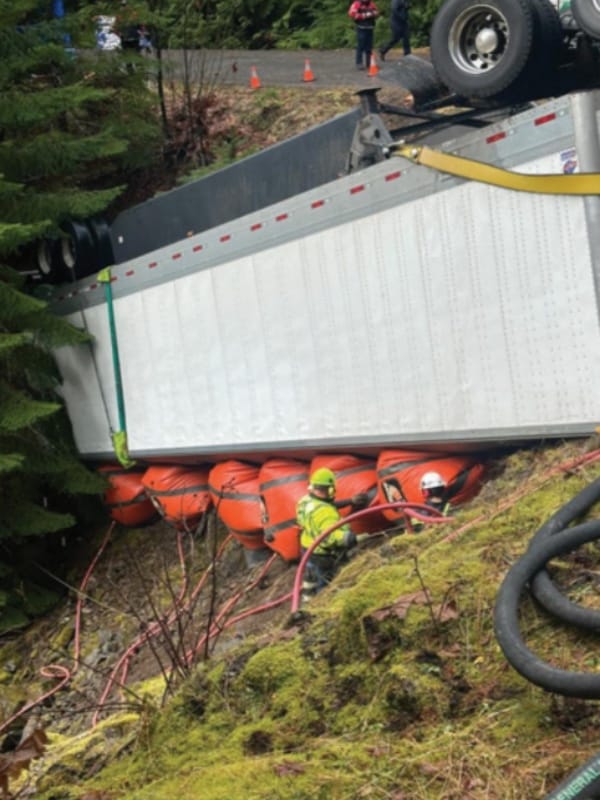
The steep and unstable location, covered in snow and ice, required a complex and high-risk operation to secure and offload the hazardous materials. The outcome would have been drastically different without the 24-hour a day support to the semi and its load, in order to keep it from sliding down into the water. This included the tow equipment, air bags, light towers, and other support apparatus, along with the operators of all this equipment. A watchman was stationed to monitor the recovery site to ensure that no one entered the recovery area to maintain public safety.
Inspection of the casualty vehicle indicated the tractor cab was twisted, with the front axle on the ground lying on its side, and the rear axle facing straight up in the air. There was also a huge boulder punched through the roof of the trailer under the trailer axles. The top rail on the downhill side was not damaged, but inconveniently located nine feet off the ground at its highest point.
The casualty was secured with six anchors held by the two rotators, using an extensive array of multiple winch lines, chains, a continuous loop with shackles, and a belly wrap with a recovery strap around the trailer. Next came the deployment of Matjack airbags.
“There was sufficient solid rock under the large gap of the trailer to hold the bottom footing of the Matjack push bags,” Donny Callahan of Gerlock recalled. “My goal was to fill the gap without lifting any of the weight of the trailer so I would not lose any anchor ability.”
Then, each of six Matjack bags were strategically placed on the rocky terrain, and inflated only enough to fill the gap but with no lift. The rigging crew ran a 60-foot ratchet strap through each handle of the Matjack bags to keep them in place. This would keep them from falling into the water below when the trailer became lighter as the snail poison bags were offloaded.
Several agencies were on scene, including a fully staffed paramedic unit.
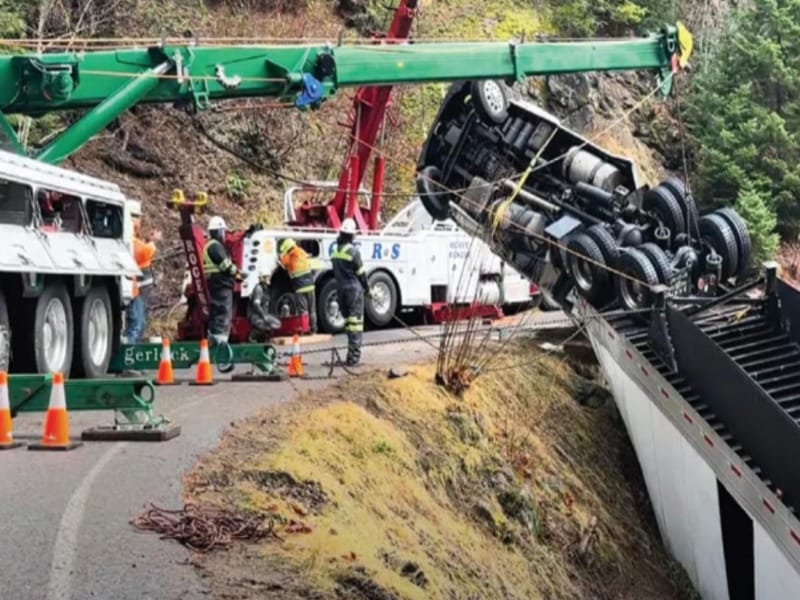
When the time came to offload, both 4×8-foot Waste Management bags and some 4×4-foot bags provided by Rogers Towing were used. After each bag was filled on the landing, they were crane lifted with the NRC CSR65 and set on Rogers’ multiple rollbacks in order to haul them down to a specific staging area for stacking into waiting van trailers. Fortunately, the semi’s trailer was offloaded without any product hitting the ground or spilling into the creek.
After all the Matjack push bags were removed, both rotators were then relocated on the hill in preparation for raising the semi. The NRC CSR65 was turned around to face the tractor’s backside, with a safety chain running from the rear outrigger to the landing gear of the trailer.
The Century 1140 was positioned in front of the tractor, leaving just enough room to land the wrecked tractor and re-rig it. A large 3.5- x 5-foot opening was to cut into the side of the trailer with a battery-powered Milwaukee Sawzall and chop saw. The crew had been instructed to be extremely careful not to cut into any of the pesticide bags, and also keep any of them from hitting the ground.
The bags of snail poison were sitting on the ceiling of the upside-down trailer. Only two people, outfitted with full climbing safety gear and ropes, were allowed into the trailer at a time, and were switched hourly. The biggest fear was the heavy load (42,000 pounds) busting through the roof and falling into the drinking water supply, quite possibly with workers unloading inside the trailer.
The tow operators deployed an Iver Tool to the front of the wrecked tractor, and connected two main winch lines to the Century 1140.
On the rear, a ½-inch Grade 100 chain was hooked to each side of the frame rail with a floating shackle, and also on the middle. In addition, a ⅜-inch chain was attached to the fifth wheel release handle.
“We strategically lifted the tractor, taking pressure off the kingpin, released the fifth wheel, and disconnected it from the trailer,” Donny related. “We then swung the tractor over to our designated landing spot and lowered it down, laying it on its side.”
Donny and his operators moved the ½-inch loop from the bottom side to the top side of the frame rail, and reattached the floating shackle. They added in a 12-foot continuous loop around the front of the cab to help with the mid-air roll.
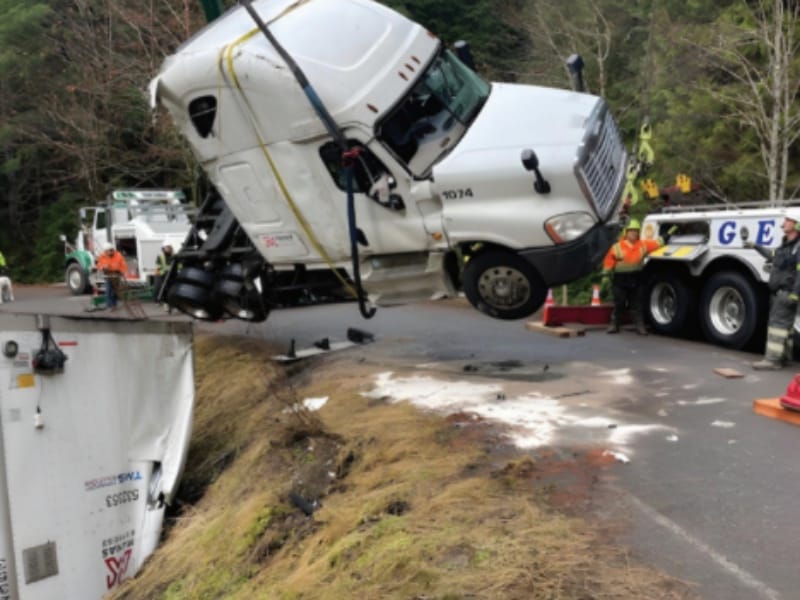
“We lifted and rolled the tractor mid-air and sat it down on its wheels,” Donny said. “We rigged down the Century 1140 and front-hooked the tractor using the Iver Tool, lifted it, and moved it up the hill to a safe landing.”
The operators then moved the NRC CSR65 next to the rear of the trailer, and backed the 1140 down next to the front of the trailer, leaving enough room to lift, swing, and land the trailer between the two rotators.
“I deployed a WreckMaster Wrinkle Lock to the kingpin and secured it in place, made a ⅜-inch Grade 100 bridle using a ⅜-inch Crosby Eliminator, and connected it to the Century 1140’s two-part line,” Donny stated. “On the back of the trailer, I hooked another ⅜-inch Grade 100 slip hook into the side rails, also making a bridle using another Crosby Eliminator.”
The crew then lifted the trailer above the road, swung it in between the rotators, and set it down on the road with blocks between them. They re-rigged with straps for a mid-air roll, and then lifted the trailer back off the ground, rotating it 180 degrees, and set it back down on its wheels. This ended the recovery portion of the job.
All told, it required a dozen, eight-hour shifts, with up to 40 operators, workers, and support personnel on scene having to function at a “snail’s pace” for safety’s sake. Rogers Towing and Gerlock Towing worked together to make this recovery a success with no injuries. The expertise of both companies was praised by all the government and rescue agencies involved, and the poison was kept under control.
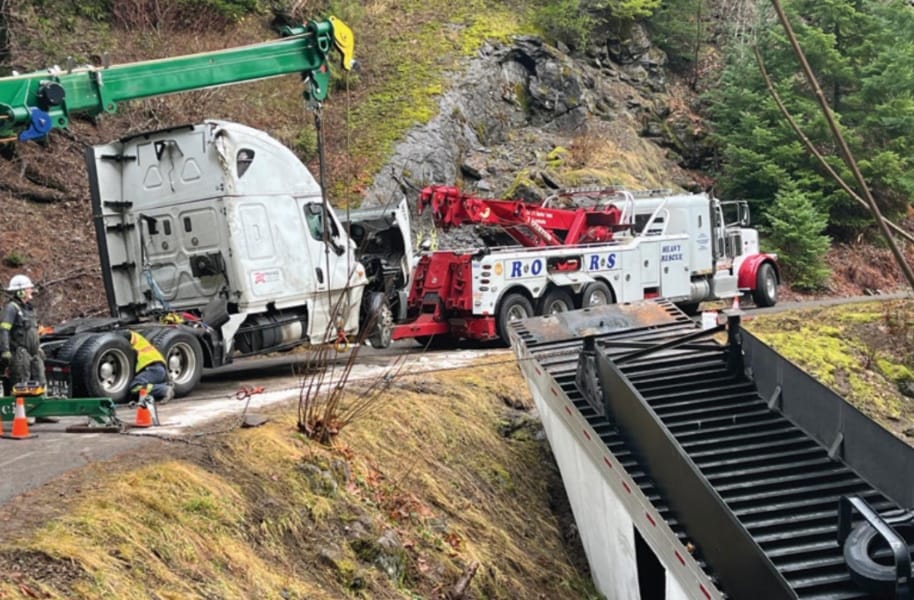
RESPONDING PERSONNEL
Gerlock Towing & Heavy Haul:
- Donny Callahan, Certified Recovery Manager
- Austin Olson, Matjack Certified Air Cushion Technician
- Kai Blue, Recovery Technician
- Dennis Krohling, Matjack Certified Air Cushion Manifold Operator
Rogers Towing & Transport:
- Tanner Rucker, Operations & Logistics Manager
- Matt Lostrom, rotator operator
- Aspen Wheeler, Landoll operator
- Nathan House
- DJ Wheeler, flatbed operator 1
- Collin Moore, flatbed operator 1
- Jesse Parker, flatbed operator 2
- Lewis Rucker, Incident Safety Officer, and Logistics Manager for the command center and reloading area
RESPONDING EQUIPMENT
- NRC CSR65 rotator / 2022 Western Star 4900
- Century 1140 rotator / 2012 Peterbilt 379
- Landoll – 2015 Freightliner FL112 Tractor
- Matjack Air Cushions
- 2019 Kenworth tractor with two van trailers
- Gerlock 2019 Dodge service truck / incident response unit
- Mobile Command Center
- Multiple trailers and pickups
- Light towers
- 10 sets of Sonetics headsets
- 30 x 30 tent for food and warming

